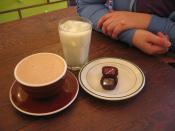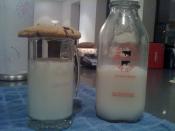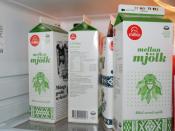CFUs/mL; Organoleptic Properties; and the effects of temperature, acid and enzymes on proteins in Selected Milks
Abstract:
This experiment examined the organoleptic properties, coagulation of proteins and microbial contamination of cow's milk. Various samples of milk were tasted for their sweetness, mouth-feel, cooked taste and creaminess, colour was also noted. Low fat milks were less creamy and less viscous than those with full milk fat. The colour of full cream milk was whiter than low fat milk.
Results for method A were unreliable due to contamination of samples; however there is some evidence that pasteurised milk contained thermophilic microorganisms.
Method B used rennet and acid to precipitate casein from whey. Whey proteins, -Lactalbumin and -lactoglobulin, were precipitated using temperatures up to 100 oC. This precipitate was brown in colour and resembled skin. Part B of method B compared the affects of temperature and acid on coagulation of milk proteins. Whey proteins coagulated at 60 oC in both acidified and non-acidified milk.
Curds formed in non-acidified milk at 60 oC and at 60 oC and 41 oC in acidified milk. Precipitates formed were lumpy. Rennet did not cause milk to coagulate in the absence of acid.
Introduction:
This experiment was divided into three components. The first method examined the bacterial counts in raw, pasteurised and sterile (UHT) milk. In the second method we precipitated proteins in milk using enzymes, acid and heat. The third part of this experiment compared the organoleptic properties of selected milks. These three methods are labelled part A, B and C respectively.
The milk discussed throughout this report is cow's milk. Milk contains lactose (a milk sugar), milk fat, protein and minerals, like calcium (Paulus, 2002).
Milk comprises of 88% water, 5% carbohydrate, 3.5% protein and 3.3% fat and has a pH of 6.6 (McWilliams, 2001, pg...


